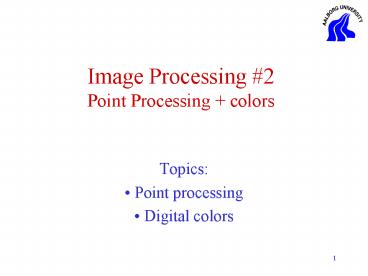Image Processing - PowerPoint PPT Presentation
1 / 25
Title:
Image Processing
Description:
... and Analysis. Free: http://rsb.info.nih.gov/ij/ Stabile (Java) Extremely easy to learn and use ... Comes with a C-like programming language, but we'll only ... – PowerPoint PPT presentation
Number of Views:75
Avg rating:3.0/5.0
Title: Image Processing
1
Image Processing 2Point Processing colors
- Topics
- Point processing
- Digital colors
2
Fundamental Steps in Computer Vision
- Today
- Image acquisition
- Pre-processing
- Segmentation
3
Point Processing
- What is point processing?
- Grey level mapping
- Histograms
- Segmentation using thresholding
But first ImageJ
4
ImageJ
- SW to do Image Processing and Analysis
- Free http//rsb.info.nih.gov/ij/
- Stabile (Java)
- Extremely easy to learn and use
- Comes with a C-like programming language, but
well only use the menus - Show
5
What is point processing?
- Only one pixel in the input has an effect on the
output - For example
- Changing the brightness, thresholding, histogram
stretching
Input
Output
6
Point processing
- Grey level enhancement
- Process one pixel at a time independent of all
other pixels - For example used to correct Brightness and
Contrast (remote control)
Too low contrast
Too high contrast
Too high brightness
Too low brightness
Correct
7
Brightness
- The brightness is the intensity
- Change brightness
- To each pixel is added the value b
- f(x,y) is the input image
- g(x,y) is the (enhanced) output image
- If bgt0 gt brighter image
- If blt0 gt less bright image
g(x,y) f(x,y) b
8
Contrast
- The contrast describes the level of details we
can see - Change contrast
- Each pixel is multiplied by a
- f(x,y) is the input image
- g(x,y) is the (enhanced) output image
- If agt1 gt more contrast
- If alt1 gt less contrast
g(x,y) a f(x,y)
9
Combining brightness and contrast
g(x,y) a f(x,y) b
- Both
- A straight line
- Greylevel mapping
- X-Axis Input Value
- Y-Axis Output Value
- This plot Identity
- Output equals Input a1 and b0
- Apply to each pixel!
- To save time the greylevel
- mapping can be written as a
- Lookup-Table
Output image g(x,y)
Input image f(x,y)
(Show bridge, signe)
10
Histogram
11
How to set the greylevel mapping
k
- Histogram processing a powerfull tool!
12
Histogram Types
Dark Image
Bright Image
Low Contrast
High Contrast
- How can a histogram help? (show PET_scan,
TEM_filter)
13
Histogram processing
- Different types of mapping
- Piecewise linear
14
Histogram processing
- Non-linear, e.g., Logarithmic
- Arbitrary
15
Improving contrast
- Humans cannot tell the difference between
greylevel values too close to each other - So spread out the greylevel values
- This is called histogram stretching
16
Histogram stretching
17
Something really different
18
Segmentation
- Until now Image processing (manipulation)
- Image analysis segmentation
- The task
- Information versus noise
- Foreground (object) versus background
19
Segmentation
- Use greylevel mapping and the histogram
- When two peaks (modes) of a histogram correspond
to object and noise (Show AuPbSn40, bridge) - Find a THRESHOLD value, T, that separates the two
peaks. This process is called THRESHOLDING - Algorithm
- If f(x,y) gt T then g(x,y) 1, else g(x,y) 0
- ( or reverse )
- Result a binary image where
- object pixels 1 and noise 0
- (Show AuPbSn40, bridge, 2Dgel, blobs)
20
Segmentation
- Often, obtaining a bi-modal histogram is the
sole purpose of the image acquisition - Lighting
- Setup
- Camera
- Lins
Background
Object
Ideal
21
Segmentation
- How to define the Theshold?
- If we have a good setup gt the Threshold is
static! - Find it during training
- But the histogram is NEVER static!!
- (show Eyesweb prg)
22
What to remember
- Point processing
- Pixel-wise operations
- Greylevel mapping
- Setting brightness and contrast
- Histogram processing
- Segmentation Thresholding. Bimodal histogram
Output image g(x,y)
Input image f(x,y)
Background
Object
23
Exercises (1/3)
- Discuss the PE-questions
- Download ImageJ http//rsb.info.nih.gov/ij/
- Use ImageJ to play around with greylevel mapping,
histograms and thresholding. Make sure you
understand these concepts!
24
Exercises (2/3)
- Download the following images from Moodle
enhance_me, dots, papir - Use ImageJ to improve the quality of the image
enhance_me - Use ImageJ to improve the image dots so that
only 28 non-connected black dots remain and the
rest is white - Use ImageJ to improve the image papir so that
the text is black and the rest is white.
25
Exercises (3/3)
- Make an algorithm (on paper) that can do
Histogram Stretching - How will the Threshold-algorithm look like if two
threshold values are used instead of just one? - Is it wise to have a binary image consisting of
0s and 1s?































